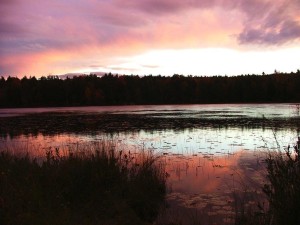The Importance of Wetlands to Maine Lakefront Property Owners
Turnkey Custom-Built Cape on Sebasticook Lake in Newport, Maine
April 10, 2014Out and About for the Bangor Lakes Region of Maine April 17-23
April 16, 2014The Importance of Wetlands to Maine Lakefront Property Owners
Maine Wetlands Provide Important Buffer Zone and Beauty
by Leigh Macmillen Hayes
Maine Master Naturalist and Executive Director of the Association of State Wetland Managers, Jeanne Christie spends her days studying lakes and their wetlands. All told, freshwater comprises about one tenth of the surface area in the State of Maine. “There are more than 6,000 lakes and ponds in the state and over 31,000 miles of rivers and streams,” Christie informs us. “Wetlands are critical to sustaining the high quality of Maine’s lakes and ponds. On average wetlands border about 20% of the shoreline of Maine’s lakes. (Vaux P. Freshwater Biodiversity in Maine. The Nature Conservancy.) While wetlands are poor sites for homes or lakeshore cabins, they are critical to the health of Maine’s lakes.”
And as lakefront property owners, it’s critical for us to understand wetlands better. Christie explains, “Wetlands found along lakes fall into two major categories: one type is made up of plants growing in the water at the edge of the lake. These are the plants that die back in the cold winter months and then grow again in the spring. Water lilies are an example of an aquatic plant found in these wetlands. They can root in water several feet deep and grow up to the surface.
The second type of wetland found along lakes is found on the shore at or slightly above the water line. These wetlands on the landward side of lakes are wet or flooded part of the year and are populated with persistent plants that don’t die back in the winter months. Examples include black spruce, bulrush and cattails. These lake fringe wetlands may occur as a narrow border along a lake edge or extend hundreds of yards back from the shore, sometimes forming extensive open, shrubby or forested wetlands adjacent to lakes.”
We need to learn to appreciate these wetlands because they are natural buffers that sustain deep clear water. Christie continues, “Since wetlands are located in lowland areas around lakes they tend to be sediment traps, either preventing sediment from entering the lake or catching sediment when it is pushed against the shore and into the vegetation where it settles out. Lake fringe wetlands stabilize the shoreline and prevent further erosion. When the wetlands store sediment and slow down runoff into the lake, they also remove nutrients like nitrogen and phosphorus, often using these nutrients to grow wetland plants. Nutrient removal prevents ugly green algal blooms from forming in lakes. Wetland along lakes can also remove some kinds of toxic chemicals if they are present.
The wetlands along lakes are also extremely important for fish and wildlife. Many of these flood seasonally in the spring when water levels are high and fish are spawning. Many fish species are far more likely to successfully reproduce if they can gain access to lowland wetlands where there are good spawning areas, plenty of food and cover for the young fry to hide from predators. Many birds and mammals also rely on wetlands along the fringe of lakes for food and a nesting habitat where they can hide from predators. These include wood ducks, hooded mergansers and green winged teal.
The food is in wetlands because of the rich green growth and the presence of large and diverse populations of macroinvertebrates. Macroinvertebrates is the scientific name for animals with no backbone including insects, mollusks and crustaceans. The richness (population and diversity) of macroinvertebrates is often a good indicator of the overall health of a lake. Examples of macroinvertebrates found in lakes are insects such as dragonflies, mayflies and caddisflies. These insects and other small spineless animals form an important part of the food chain and are critical food for birds, mammals and fish. In a food chain, the insects are eaten by fish and other predators which are eaten by larger predators. For example, an adult loon eats two pounds of fish a day. The fish that the loon eats had to have food too. The food chain that supports the loon and other desirable wildlife are dependent on the health of the lake’s wetlands.”
We encourage you to think differently about the area around your lakefront property. Do you need that grassy lawn that requires upkeep? Is it really essential that you have a sandy beach? As Christie says, “A grassy lawn and a sandy shore are highly desirable to many lakeside landowners, but they create a virtual desert for many of the fish and wildlife that live around the lake. Lawns and sandy beaches are also often a source of runoff that is dangerous to the lake’s health. In contrast, wetlands help keep lakes clean. They are also the equivalent of a vibrant downtown full of stores, homes, friends, family and everything they need to survive.
The challenge is to find the right balance so that everyone can thrive!”
To learn about lakefront properties for sale on Sebago Lake, click on the green box above.
To learn more about buffer zones, check out the blog links below.
Improving Water Quality Begins with Lakefront Property Owners
Maine Lakefront Owners Need to Know About Buffer Zone Management

